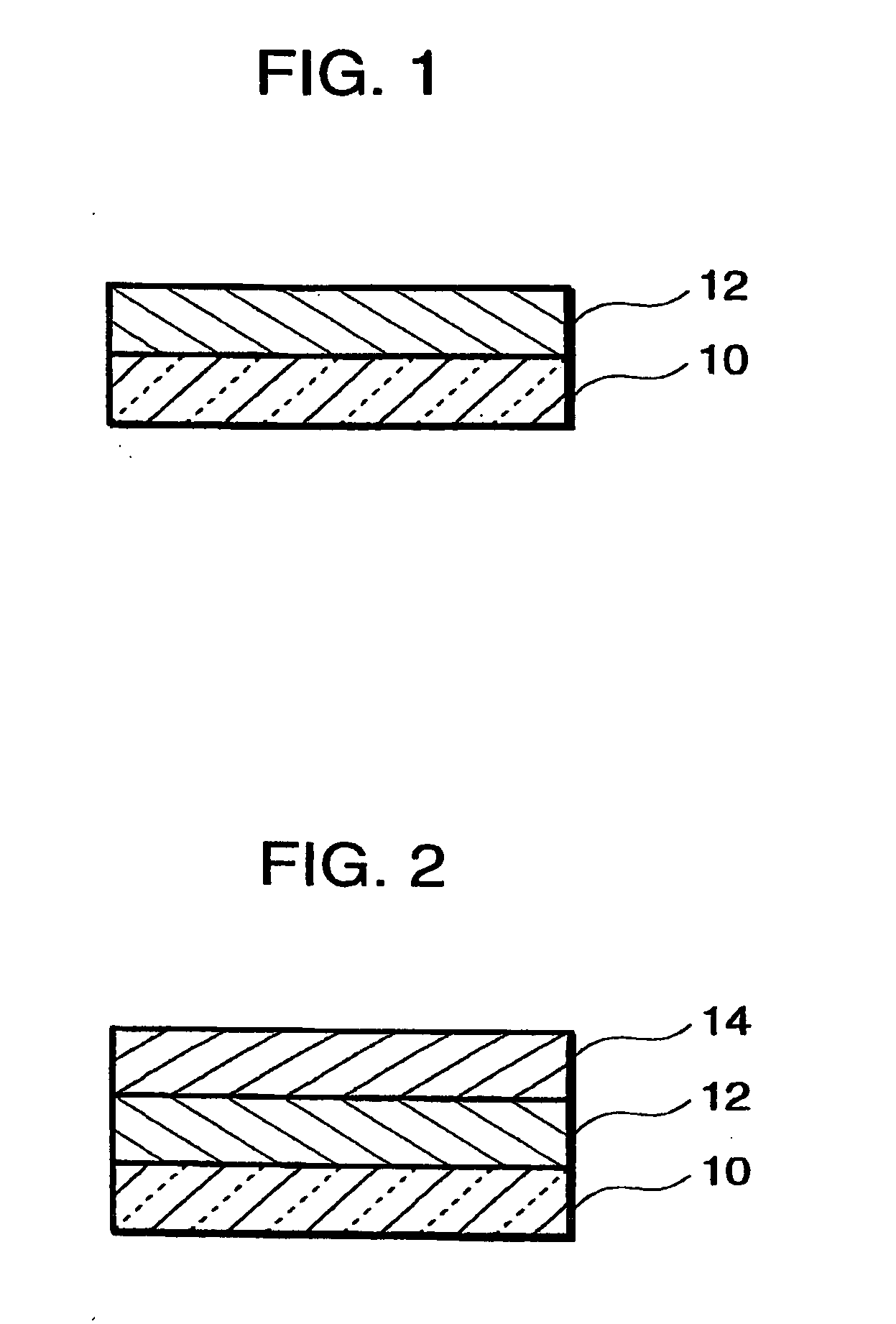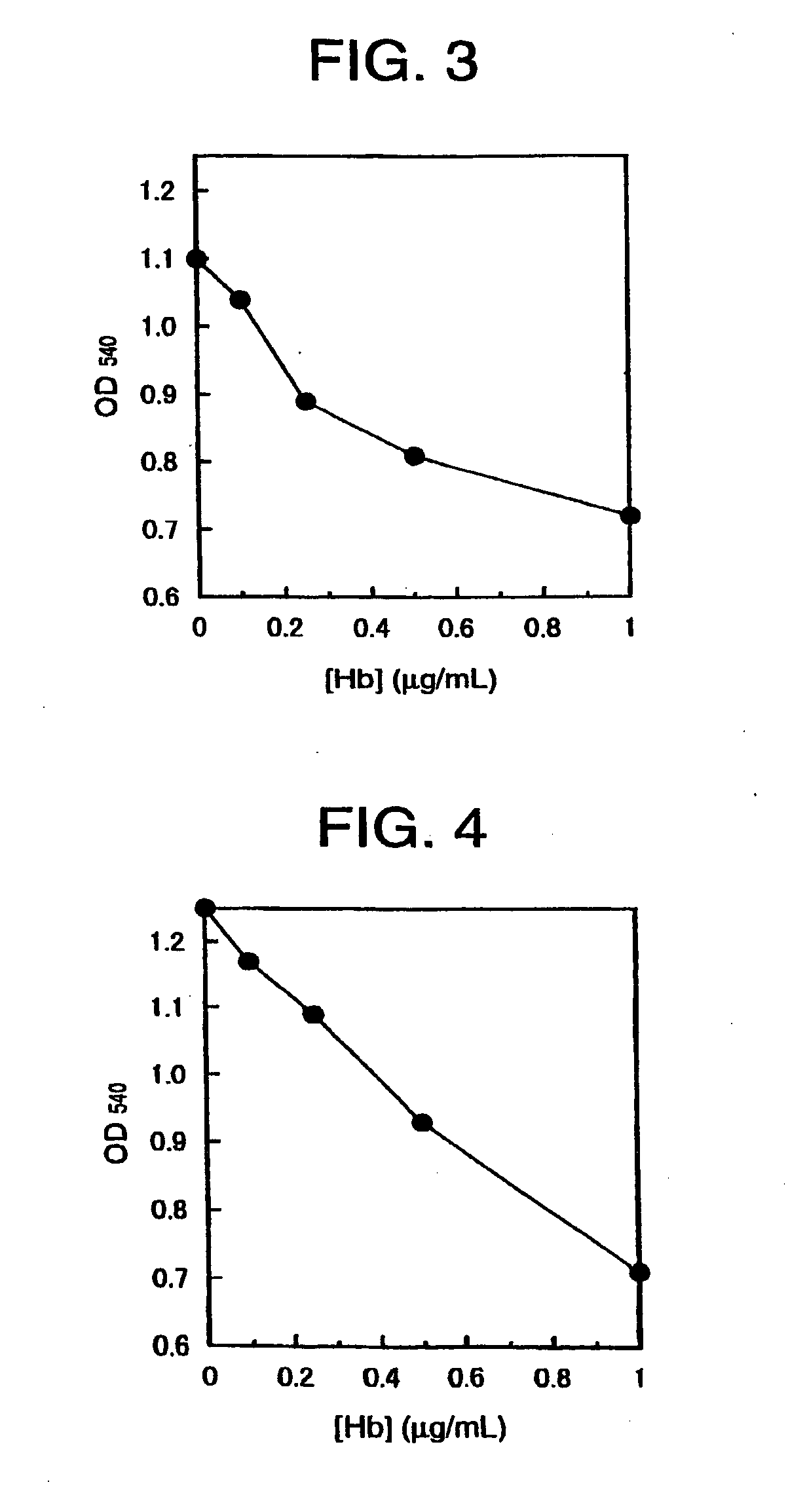Agglutination assay method in binder medium
a binder medium and assay method technology, applied in the field of detecting and analyzing trace substances, can solve the problems of poor storage stability of latex reagents, cumbersome operation, and inconvenient use of colloidal gold solutions or dispersions, and achieve high sensitive analysis, excellent stability, and simple operation
- Summary
- Abstract
- Description
- Claims
- Application Information
AI Technical Summary
Benefits of technology
Problems solved by technology
Method used
Image
Examples
example 1
Selection of Water-Soluble Polymer to which Colloidal Metal is Incorporated
[0070] Experiments of agglutination in solution system were conducted as described below while using an immunological kit for detecting fecal occult hemoglobin “Immuno-Gold Hem” (produced by Goclo Shusei Co., Ltd., sold by Wako Pure Chemicals Industries Ltd.). Various polymers were added to the reaction system so as to make the final concentration to be 1.6% by weight. As described in Example 4 mentioned below, in the case that a reagent layer was prepared with using a water-soluble polymer as binder, usually around 3% solution of the polymer was coated on a support, whereby the coverage of the polymer being about 7.5 g / m2. When about 10 mL of an aqueous sample was spotted on the reagent layer having such coverage of the polymer, the aqueous sample spreads in the reagent layer to result in a disc shape having a diameter of about 5 mm. From calculation based on the liquid amount at spotting and the spread ar...
example
Selection of Gelatin to which Colloidal Metal is Incorporated
[0077] Experiments were conducted while using an immunological kit for detecting fecal occult hemoglobin “Immuno-Gold Hem” (product of Godo Shusel Co., Ltd., sold by Wako Pure Chemicals Industries Ltd. Entirely the same operation was conducted as in Example 1 with the exception that each of various gelatins instead of various water-soluble polymers was added to the colloidal gold-labeled antibody solution so as to make the amount to be 2.5% by weight. The final concentration of the gelatin in the reaction mixture for the agglutination was 16% which is the same as that in Example 1. Table 2 shows the results. The solution viscosity shown in Table 2 is a viscosity (cP) measured at 40° C. by means of B-type viscometer after said gelatin has been added, in an amount of 2% of the mixture, to 50 mM sodium citrate solution (pH 6.0) containing 0.1% sodium azide and 0.01% Triton X-100.
TABLE 2MolecularGelatinWeightViscosity (cP)...
example 3
Selection of Carboxymethylated Starch to which Colloidal Metal is Incorporated
[0080] Similar to Examples 1 and 2, experiments were conducted while using an immunological kit for detecting fecal occult hemoglobin “Immuno-Gold Hem” (product of Godo Shusei Co., Ltd., sold by Wako Pure Chemicals Industries Ltd.). Entirely the same assay was conducted as in Example 1 with the exception that each of a carboxymethylated starch (CM-starch) as water-insoluble and water-swellable polymer instead of various water-soluble polymers in Example 1 was added to the colloidal gold-labeled antibody solution so as to make the concentration as shown in Table 3. Table 3 shows the results.
TABLE 3CM-Starch Concentration(v / w / )DOD%0.0% (control)0.6381000.5%0.606951.0%0.543851.5%0.585922.0%0.46473
[0081] As apparent from Table 3, in the case of carboxy-methylated starch, sufficient AOD value was obtained even when the starch was added in an amount of up to 2% to the colloidal gold-labeled antibody solution...
PUM
 Login to View More
Login to View More Abstract
Description
Claims
Application Information
 Login to View More
Login to View More - R&D
- Intellectual Property
- Life Sciences
- Materials
- Tech Scout
- Unparalleled Data Quality
- Higher Quality Content
- 60% Fewer Hallucinations
Browse by: Latest US Patents, China's latest patents, Technical Efficacy Thesaurus, Application Domain, Technology Topic, Popular Technical Reports.
© 2025 PatSnap. All rights reserved.Legal|Privacy policy|Modern Slavery Act Transparency Statement|Sitemap|About US| Contact US: help@patsnap.com



